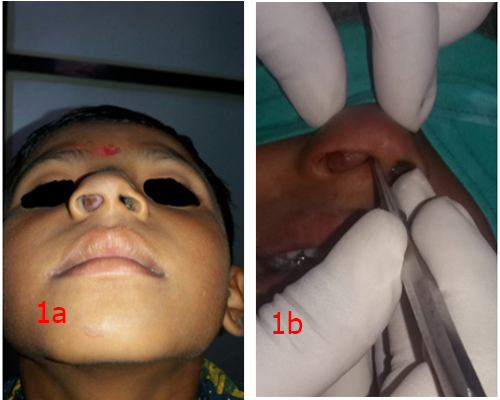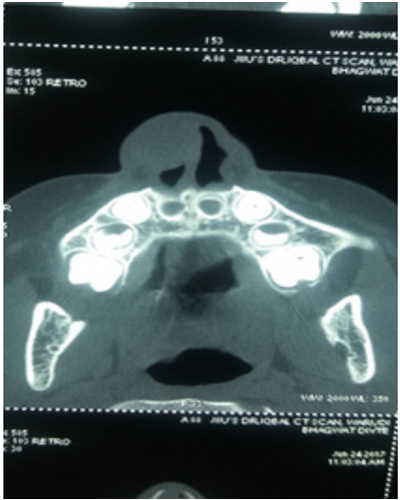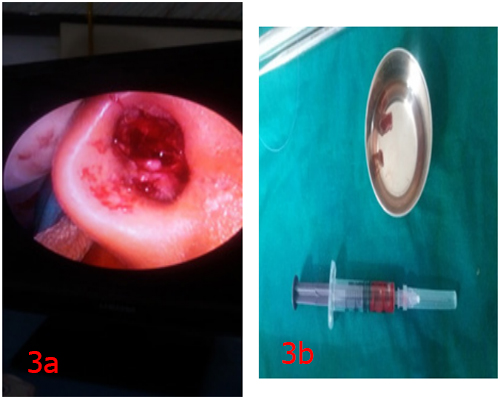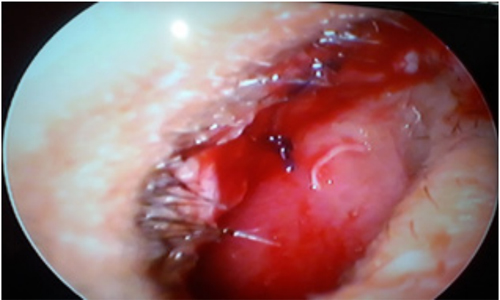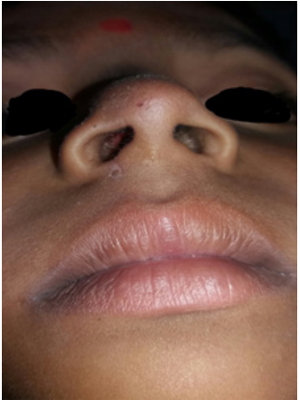Previous Issues Volume 1, Issue 1 - 2018
Nasal Alar Hematoma: An Uncommon Case Report
Chintale sambhaji govind*, Kirdak vilas rambhau, Jatale sonali praful, Shaikh kaleem
ENT Department, Jiius iimsr warudi tq. Badnapur, jalna, muhs nashik university, India
Corresponding Author: Chintale sambhaji govind, ENT department, Jiius iimsr warudi tq badnapur, Maharastra India, Tel:+919970323030; E-Mail: [email protected]
Received Date: 02 Sep 2017 Accepted Date: 11 Sep 2017 Published Date: 15 Sep 2017
Copyright © 2017 Chintale SG
Citation: Chintale SG, Kirdak VR, Jathale SP and Shaik kA. (2017). Nasal Alar Hematoma: An Uncommon Case Report. M J Otol. 1(1): 001.
ABSTRACT
A male child 6 year old presenting acutely, following trauma, with the clinical appearance of a right nasal mass appearance like 'blueberry'within the right nasal vestibule since 7 days. We recommend early surgical drainage and excision of this lesion, as delay in definitive treatment may give rise to a cosmetic deformity.
INTRODUCTION
The nose is one of the body regions that most frequently experience trauma. [1] For this reason, it is also the area of the face that most frequently experiences fractures. [1,2] Although the fracture of nasal bones, simple or complex, [ 3] is not the only consequence that can accompany trauma. [1-9] among the most important secondary effects of nasal trauma is vascular damage without drainage, which is complicated by the formation of a hematoma. [1-3] Nasal hematomas are principally found at the nasal septal level and, if not treated adequately, can present severe complications. [1-10] Very few cases of nasal hematomas affecting other areas of the nasal septum have been reported. [11, 12] Till date only 8 to 10 cases were found in literature in which the lesion was present at the level of the alar cartilage and nasal tip. We present a case of a hematoma of the nasal alar cartilage and nasal tip, which appeared following a slight nasal trauma due to fall on ground in 7 year old child. Emphasis should be placed on the importance of early diagnosis and treatment in this type of lesion to maximally prevent aesthetic complications and alterations.
CASE REPORT
A 6year old child sought medical consultation for right sided nasal mass and swelling over right side of nasal tip since 7days following history of fall on ground . Seven days following the history of fall patient experienced progressive swelling of the right nasal cavity and over tip of nose without evident bleeding. Parents of patient sought consultation after 7th day of the incident. We saw the patient with a serious nasal respiratory obstruction from right nasal cavity and there was swelling over tip of nose on right side and nasal mass in right nasal cavity as shown in Figure [1 a & b].
Figure 1:Nasal swelling [RT alar hematoma] b] Probe testing of nasal mass.
Then we decide to do routine investigation like the complete blood count and chemical analyses like random blood sugar level, kidney function test and liver function test and they showed no abnormalities and did not reveal any blood dyscrasias. The computed tomographic scan revealed irregular borders of the distal right nasal cartilage accompanied by severe swelling of the soft tissues on the dorsum of the nasal pyramid, with prominence toward the right Figure [2].
Figure 2:CT image of nasal swelling.
An increased volume was also observed on the superior portion of the cartilaginous septum, which produced contact between the septum and the internal valve region. No calcifications, foreign bodies, septum deviations, turbinate alterations, or components of an infiltrating lesion were observed. A surgical exploration was performed using inhaled general anesthesia to determine the cause of the swollen mass. After previously infiltrating the nasal tip and distal septum with lidocaine and epinephrine at 1:200,000, we proceeded to explore the nasal swelling we firstly aspirated the material in the swelling this come as blood stained purulent discharge that give us clear idea of hematoma with infection then we give cut over swelling to drain it completely and then remaing tissue we excised and sent for histopathology figure [3 a, b].
Figure 3a: nasal cavity after excision.Figure 3b: aspirated and excised sample.
The alar cartilages were repaired with 4-0 Vicryl sutures to restore their continuity. The nasal mucosa was closed with 5-0 chromic sutures figure [4].
Figure 4: Nasal mucosa suturing.
Histologically we found severe chronic inflammatory changes consistent with mature lymphocytes that were dispersed, with granular tissue and neovascularization. Granular posttraumatic tissue with-out any microorganisms was reported. The patient demonstrated significant aesthetic improvement within 10 days postoperatively, at 2-month follow-up, the patient continued to experience no problems figure [5].
Figure 5: F/U image showing normal nasal cavity.
DISCUSSION
Trauma around the nasal region is a common problem.[1-3] Its high incidence is due to the nose position in the center of the face.[1] Because of the anatomical characteristics of the nasal bones and the poor support that the septal cartilage offers, lesions to these structures are very common following nasal trauma.[1- 2 ] Lesions of the nasal bones and septal cartilage can be of a combined or isolated form, depending on multiple factors.[ 3] The septal cartilage lesion can be manifested in a simple form, which is more common.[3] It can be accompanied by other alterations that completely change its management. A septal hematoma is one of the most serious lesions that can accompany a septal cartilage lesion and should be considered a medical emergency. [1-4, 8-9] A septal hematoma is an infrequent complication, secondary to bleeding between the cartilage and the mucoperichondria. [3, 7, 8] Its presence is generally secondary to nasal trauma, [1-4] which can inclusively be slight, although there are reports of spontaneous non traumatic etiologies. [6, 7, 9] If the hematoma is not evacuated, it could evolve into different forms. Less problematic is its self-organization with the formation of fibrous tissue, thickening of the septum, and posterior obstruction of the nasal air passage. [3, 9] On other occasions, it produces weakness in the septal cartilage secondary to inadequate vascularization.
[3] Or a true necrosis that produces deforming aesthetics of the nose. [1-4, 8, 9] If not treated, the hematoma can become infected, and severe complications can develop, ranging from a severe aesthetic deformity to an intra- cranial infection to death due to a cerebral abscess. [7,10] For this reason, surgical treatment should be immediate to achieve drainage and to avoid more serious complications.[1-4,8,9] It is also recommended that antibiotic therapy be combined with the surgical management.[8,9]Even though there have been many reports of septal hematoma following nasal trauma, there are only few reports of hematomas in other regions of the nose secondary to trauma. [11,12] Less frequent is the presence of hematomas affecting the lateral cartilages to date, fewer than 10 reported cases exist in the world literature. [12] In these cases, the predisposing cause was always nasal trauma, with the majority of these cases occurring in children. [11] Usually the clinical data on these lesions are not as severe as with the existence of a septal hematoma, because they sometimes are present as a small mass in the nasal vestibule. [12] Nevertheless, on occasion, the reaction and evolution are similar to those of a septal hematoma, accompanied by a severe deformity when treatment is delayed. [12] Therefore, treatment is immediate surgery. The low incidence of this type of lesion led the patient to seek medical attention at various clinics without a precise diagnosis being made, which delayed early definitive treatment. Because of the large existing deformity, during the operation, Traumatic nasal lesions are very frequent, and may present differing complications. The appearance of hematomas secondary to trauma is rare, but when it does occur, it affects the cartilaginous portions of the septum. A hematoma affecting other areas is extremely rare, which makes diagnosis difficult, especially when its evolution is slow; the hematoma can also be confused with a tumor. [13]
CONCLUSION
Emphasis should be placed on the importance of early diagnosis and treatment in this type of lesion to maximally prevent aesthetic complications and alterations. The deformities and consequences that may occur are equally severe when a hematoma exists in the septal cartilage region. Therefore, one should always consider that a hematoma may be present following nasal trauma and can affect any nasal anatomic region. Surgery is the treatment of choice, with maximal exposure of the nasal structures, if indicated.
ACKNOWLEDGEMENTS
This study is carried out at our institute thank to my teachers seniors and colleague who help to make this very rare case report.
REFERENCES
- Mathog RH. (1992). Nasal fractures in R H Mathog (Ed.). Atlas of Craniofacial Trauma. Philadelphia: Saunders.
- Kastenbauer ER and Masing H. (1995). Intranasal surgery and the management of acute nasal injuries. In M. E. Tardy and E. R. Kastenbauer (Eds.). Head and Neck Surgery: Face, Nose and Facial Skull. New York: Thieme Medical Publishers.
- Converse JM and Dingman RO. (1977). The clinical management of facial injuries and fractures of the facial bones. JM. Converse (Ed.). Reconstructive Plastic Surgery. Philadelphia: Saunders.
- Kryger H and Dommerby H. (1987). Haematoma and abscess of the nasal septum. Clin. Otolaryngol. 12(2): 125- 129.
- Matsuba HM and Thawley SE. (1986). Nasal septal abscess: Unusual causes, complications, treatment, and sequelae. Ann. Plast. Surg. 16(2): 161-166.
- Alvarez H, Osorio J, De Diego JI, Prim MP. et al. (2000). Sequelae after nasal septum injuries in children. Auris Nasus Larynx. 27(4): 339-342.
- Chukuezi AB. (1992). Nasal septal haematoma in Nigeria. J. Laryngol. Otol. 106(5): 396-398.
- Ginsburg CM. (1998). Nasal septal hematoma. Pediatr. Rev. 19(4): 142.
- Lopez MA, Liu JH, Hartley BE, and Myer CM. (2000). Septal hematoma and abscess after nasal trauma. Clin. Pediatr. (Phila). 39(10): 609-610.
- Jalaludin MA. (1993). Nasal septal abscess: Retrospective analysis of 14 cases from University Hospital, Kuala Lumpur. Singapore Med. J. 34(5): 435-437.
- Meehan T, Kaddour H, and Lannigan FJ. (1994). Alar cartilage haematoma. J. Laryngol. Otol. 108(6): 500-502.
- Green KM, Board T, and Mason JD. (1999). Alar haematoma. J. Laryngol. Otol. 113(12): 1104-1105.
- Unlu HH, Mutlu C, Ayhan S, and Tarhan S. (2001). Organized hematoma of the maxillary sinus mimicking tumor. Auris Nasus Larynx. 28(3): 253-255.
